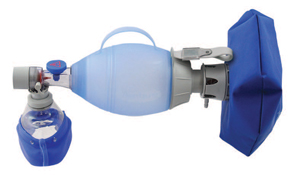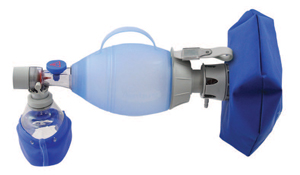RESUSCITATOR MANUAL (Ambu), child + masks RH2/S1
Valid Article
RESUSCITATOR child (Ambu)
Definition
A hand-operated device designed to provide or assist ventilation in children who are apnoeic or exhibit inadequate respiration. It employs entrained ambient air and includes a large flexible chamber that is hand-ventilated, a gas reservoir, tubing, and a connector for attachment to a mask or endotracheal tube; oxygen may also be connected when necessary.
It is used by emergency medical services in ambulances, intensive care units, during internal patient transfer, accident and emergency, mass casualty incidents, and is generally placed strategically throughout a hospital.
Specifications
Quality standards
Technical specifications
- SELF-INFLATING BAG
- self-inflating and compressible balloon in transparent silicone
- maximum bag volume: 635 ml
- maximum stroke volume: 450 ml
- air intake valve
- patient valve connection
- fitted with a handle allowing the use with one hand only and regular inflations
- autoclavable 30x
- PEDIATRIC PATIENT VALVE
- non rebreathing device, one-way, with unique valve inlet
- translucent polysulphone
- fitted with a pressure limiting valve with pop-off cap (40 cm H2O)
- patient connector ISO 22/15 mm
- male respiratory connector ISO 30 mm, female respiratory connector ISO 24 mm
- dead space < 6 ml
- inspiratory resistance at 5 l/min: < or = to - 5 cm of H2O
- expiratory resistance at 5 l/min: < or = to 5 cm of H2O
- silicone valve inlet (different than the red adult valve inlet)
- MASK nº RH2
- transparent polysulphone shell
- silicone rubber blue rim
- fitted with metal hookring
- adjustable on 22/15 mm connections
- MASK nº S1
- transparent silicone
- adjustable on 22/15 mm connections
- OXYGEN RESERVOIR BAG
- coated nylon (dark blue)
- capacity: 1500 ml
- autoclavable 15 x
- Easy to disassemble for cleaning
- All components are autoclavable up to 134ºC
- Latex free
- Non sterile
Instructions for use
Forms part of the emergency resuscitation equipment. Should always be kept ready for use: visible, clean, complete and in good working order.
Should only be used by experienced staff.
The use of the oxygen reservoir bag is recommended if oxygen is available, as it enables to enrich the inspired gas with oxygen.
Precautions for Use
The patient valve is different for the adult/child self-inflating bag and the child self-inflating bag. The childself-inflating bag must be used with the "paediatric" patient valve (see related articles below).
Never obstruct the pressure relief valve, unless medically indicated. High pressures can cause pulmonary lesions.
Maintenance
Before use:
- Check that the valve outlet operates correctly (it should not stick), by gently breathing through the valve whilst watching the flap move.
- Check the elasticity of the bag by manual pressure.
After each use:
- The patient valve and the masks must be pre-disinfected, cleaned and sterilized by steam autoclave
(Cf Introduction: Disinfection and sterilization in the field)
MSF requirements
Device used for manual ventilation assistance in children with weight between 10 and 30 kg, in case of respiratory distress or failure.





![[KMEDMHIE21-] (mod ICU) EXAMINATION-RESUSCITATION EQUIPMENT](/web/image/product.template/574340/image_256/%5BKMEDMHIE21-%5D%20%28mod%20ICU%29%20EXAMINATION-RESUSCITATION%20EQUIPMENT?unique=22350c3)
![[KMEDMHOE17-] (mod OT Room) ANESTHESIA-RESUSCITATION EQ.](/web/image/product.template/572539/image_256/%5BKMEDMHOE17-%5D%20%28mod%20OT%20Room%29%20ANESTHESIA-RESUSCITATION%20EQ.?unique=8f85d22)
![[KMEDMHOE11-] (mod OT Room) RECOVERY EQUIPMENT, 2 beds](/web/image/product.template/572534/image_256/%5BKMEDMHOE11-%5D%20%28mod%20OT%20Room%29%20RECOVERY%20EQUIPMENT%2C%202%20beds?unique=fb9a656)
![[KMEDMNUTI35] (module nut. inpatient) RESUSCITATION ITEMS 2021](/web/image/product.template/575291/image_256/%5BKMEDMNUTI35%5D%20%28module%20nut.%20inpatient%29%20RESUSCITATION%20ITEMS%202021?unique=f928ae9)
![[EANEMASARH2] MASK ANAESTHESIA + RIM + HOOK, size 2, child](/web/image/product.template/569434/image_256/%5BEANEMASARH2%5D%20MASK%20ANAESTHESIA%20%2B%20RIM%20%2B%20HOOK%2C%20size%202%2C%20child?unique=478a81f)
![[EANERESU201] (resuscitator Ambu adult/child) OXYGEN RESERVOIR complete](/web/image/product.template/569375/image_256/%5BEANERESU201%5D%20%28resuscitator%20Ambu%20adult-child%29%20OXYGEN%20RESERVOIR%20complete?unique=478a81f)
![[EANERESU204] VALVE for resuscitator manual Ambu, PAEDIATRIC complete](/web/image/product.template/569295/image_256/%5BEANERESU204%5D%20VALVE%20for%20resuscitator%20manual%20Ambu%2C%20PAEDIATRIC%20complete?unique=478a81f)
![[EANERESU2AC] RESUSCITATOR MANUAL (Ambu), ad./child + masks RH5 / RH2](/web/image/product.template/569378/image_256/%5BEANERESU2AC%5D%20RESUSCITATOR%20MANUAL%20%28Ambu%29%2C%20ad.-child%20%2B%20masks%20RH5%20-%20RH2?unique=478a81f)
![[SCTDBRCF1A-] FILTER, BREATHING CIRCUIT, 22M/15F, adult/child, s.u.](/web/image/product.template/571898/image_256/%5BSCTDBRCF1A-%5D%20FILTER%2C%20BREATHING%20CIRCUIT%2C%2022M-15F%2C%20%20adult-child%2C%20s.u.?unique=6fb9a30)